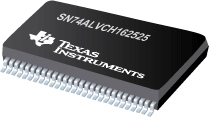Transceptor registrado de 18 bits con salidas de 3 estados 56-TSSOP -40 a 85
PDF, 43 Kb, Archivo publicado: agosto 3, 1998
The PC100 standard establishes design parameters for the PC SDRAM DIMM that is designed to operate at 100 MHz. The 168-pin, 8-byte, registered SDRAM DIMM is a JEDEC-defined device (JC-42.5-96-146A). Some of the defined signal paths include data signals, address signals, and control signals. This application report discusses the SN74ALVC16835 18-bit universal bus driver that is available from T
PDF, 96 Kb, Revisión: A, Archivo publicado: mayo 13, 1998
Design of high-performance personal computer (PC) systems that are capable of meeting the needs imposed by modern operating systems and software includes the use of large banks of SDRAMs on DIMMs (see Figure 1).To meet the demands of stable functionality over the broad spectrum of operating environments, meet system timing needs, and to support data integrity, the loads presented by the large
PDF, 895 Kb, Revisión: B, Archivo publicado: mayo 22, 2002
TI?s 56-ball MicroStar Jr.E package registered under JEDEC MO-225 has demonstrated through modeling and experimentation that it is an optimal solution for reducing inductance and capacitance improving thermal performance and minimizing board area usage in integrated bus functions. Multiple functions released in the 56-ball MicroStar Jr.E package have superior performance characteristics compa
PDF, 105 Kb, Revisión: A, Archivo publicado: agosto 1, 1997
The spectrum of bus-interface devices with damping resistors or balanced/light output drive currently offered by various logic vendors is confusing at best. Inconsistencies in naming conventions and methods used for implementation make it difficult to identify the best solution for a given application. This report attempts to clarify the issue by looking at several vendors? approaches and discussi
PDF, 253 Kb, Archivo publicado: mayo 1, 1996
PDF, 115 Kb, Archivo publicado: dic 1, 1997
This application report explores the possibilities for migrating to 3.3-V and 2.5-V power supplies and discusses the implications.Customers are successfully using a wide range of low-voltage 3.3-V logic devices. These devices are within Texas Instruments (TI) advanced low-voltage CMOS (ALVC) crossbar technology (CBT) crossbar technology with integrated diode (CBTD) low-voltage crossbar techn
PDF, 154 Kb, Revisión: A, Archivo publicado: sept 8, 1999
In the last few years the trend toward reducing supply voltage (VCC) has continued as reflected in an additional specification of 2.5-V VCC for the AVC ALVT ALVC LVC LV and the CBTLV families.In this application report the different logic levels at VCC of 5 V 3.3 V 2.5 V and 1.8 V are compared. Within the report the possibilities for migration from 5-V logic and 3.3-V logic families
PDF, 150 Kb, Archivo publicado: oct 1, 1996
Many applications require the ability to exchange modules in electronic systems without removing the supply voltage from the module (live insertion). For example an electronic telephone exchange must always remain operational even during module maintenance and repair. To avoid damaging components additional circuitry modifications are necessary. This document describes in detail the phenomena tha
PDF, 1.7 Mb, Archivo publicado: oct 1, 1996
This report contains a comprehensive collection of the input and output characteristic curves of typical integrated circuits from various logic families. These curves go beyond the information given in data sheets by providing additional details regarding the characteristics of the components. This knowledge is particularly useful when for example a decision must be made as to which circuit shou
PDF, 89 Kb, Revisión: B, Archivo publicado: jun 1, 1997
Reduction of power consumption makes a device more reliable. The need for devices that consume a minimum amount of power was a major driving force behind the development of CMOS technologies. As a result CMOS devices are best known for low power consumption. However for minimizing the power requirements of a board or a system simply knowing that CMOS devices may use less power than equivale
